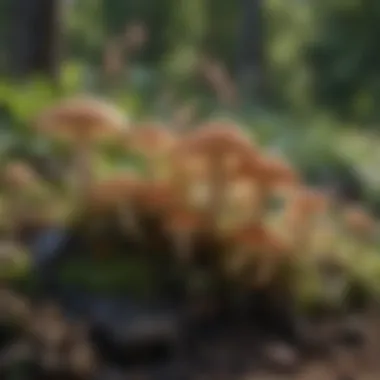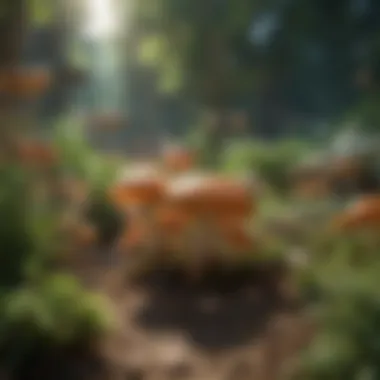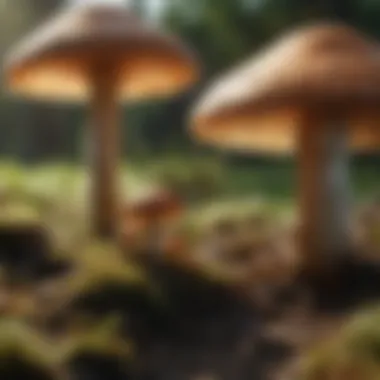Mushrooms for the Garden: A Comprehensive Guide


Intro
Mushrooms hold a unique position in the gardening world. They are often seen just as food or growth on decaying matter, but their role in the garden is much more complex and beneficial. Many gardeners overlook mushrooms, yet they can enrich the soil, aid plant growth, and create a more diverse ecosystem. The following sections will unpack the offterings of mushrooms in a garden setting, highlighting key concepts, recent trends, and practical applications in mushroom gardening.
Key Concepts and Terminology
Basic Definitions
Mushrooms are the fruiting bodies of fungi. They can be classified into different types based on their ecological roles. Some mushrooms are decomposers, breaking down dead organic matter. Others form symbiotic relationships with plants, enhancing their nutrient uptake – these are called mycorrhizal fungi. Understanding these terms is essential for anyone considering integrating mushrooms into their garden.
Historical Context
Historically, humans have utilized mushrooms for both culinary and medicinal purposes. Cultivation of edible mushrooms began thousands of years ago, with ancient Egyptians valuing them for their taste and supposed immortality properties. In modern times, the focus has shifted towards understanding their ecological benefits and applications in sustainable gardening. This historical backdrop can create a more profound appreciation of mushrooms in contemporary agricultural practices.
Recent Innovations and Trends
Technological Advancements
The rise of biotechnology has led to new methods for cultivating mushrooms efficiently. Controlled environment agriculture allows growers to produce mushrooms year-round, irrespective of climatic conditions. Advanced spore technology has made it easier to cultivate specific types of mushrooms tailored to regional conditions.
Sustainable Practices
Sustainability is a growing trend in agriculture. Mushroom gardening is notable for its low carbon footprint. Techniques like using agricultural waste as a substrate for mushroom cultivation not only recycle excess materials but also improve soil quality. This creates a closed-loop system that benefits both growers and the environment.
Practical Applications and Techniques
Step-by-step Guides
Integrating mushrooms into your garden can be simple with a few essential steps:
- Choose the right mushroom type: Start with varieties like Shiitake, Oyster, or Lion's Mane, which adapt well to various garden conditions.
- Select the right substrate: For many mushrooms, wood logs or straw work well. Ensure the substrate is free from contaminants.
- Inoculate the substrate: Introduce mushroom spores or mycelium to your chosen substrate. This can typically be done by drilling holes into logs and placing spore plugs inside.
- Maintain humidity and temperature: Mushrooms grow best in humid conditions. Keep the area moist and within the optimal temperature range for the chosen species.
- Harvest: Monitor your mushrooms closely, and harvest them at peak maturity for the best flavor.
Case Studies
Various gardens have remarkably benefited from mushroom cultivation. For example, community gardens in urban environments have begun incorporating mushrooms to not only enhance food production but also to improve soil structure and health. Reports show increased biodiversity, which can enhance pollination rates and overall plant health.
"Mushrooms have the potential to revolutionize how we think about gardening. By integrating fungi, we cultivate a thriving ecosystem that serves multiple purposes."
Mushrooms in gardens present a valuable opportunity to enrich the growing process, enhance soil health, and contribute to sustainable practices. As interest in eco-friendly gardening continues to rise, understanding the full implications of mushroom cultivation becomes increasingly relevant.
Prelims to Mushrooms in Gardening
Mushrooms play a critical role in the ecosystem and more specifically in gardening. Integrating mushrooms into your garden can offer numerous benefits, ranging from enhancing soil health to improving plant vitality. Understanding the basics of mushroom biology gives insight into their significance. By appreciating how fungi interact with plants and soil, gardeners can leverage this relationship for better garden outcomes.
The Significance of Fungi
Fungi, including mushrooms, are essential components of soil ecosystems. They break down organic matter, recycling nutrients back into the soil. This process is vital for sustaining soil health and fertility. Moreover, fungi form symbiotic relationships with plant roots, a phenomenon known as mycorrhiza. This relationship enhances nutrient uptake for plants while providing fungi with carbohydrates. Different types of fungi each contribute to different aspects of soil quality, making fungi a diverse ally in gardening efforts.
Another significant function of fungi is their ability to improve soil structure. The hyphal networks created by fungi help bind soil particles together, which can enhance aeration and water retention. This improved soil structure supports healthier plant growth and resilience, cultivating a robust garden.
Mushrooms as Beneficial Organisms
Mushrooms can provide many benefits in a garden setting. They can be decomposers, helping to break down organic materials such as dead plants and animals. This decomposition enriches the soil with nutrients, fostering a fertile environment for new growth.
Mushrooms also play a role in pest control. Certain species can suppress harmful pests in the garden, reducing the need for chemical interventions. They also contribute to the biodiversity of the garden, promoting a balanced ecosystem.
Mushrooms can also be directly beneficial to gardeners by producing edible varieties, enhancing both culinary options and potential nutritional benefits. Growing edible mushrooms like Shiitake or Oyster mushrooms adds value and diversity to your harvest.
In summary, understanding the role and advantages of fungi and mushrooms is essential for any gardener. By recognizing their contributions, one can make more informed decisions about integrating these organisms into gardening practices.
Varieties of Mushrooms Suitable for the Garden
Mushrooms come in diverse varieties, each having unique benefits and growing requirements. Recognizing suitable mushroom varieties for gardens is vital for successful cultivation. Different mushrooms can serve various purposes, such as enhancing soil health, providing food, or offering medicinal properties. Understanding which types to grow can lead to personal satisfaction and improve the overall ecosystem of the garden.


Edible Mushroom Varieties
Button Mushrooms
Button mushrooms, often found in grocery stores, are a common choice for home gardens. They are easy to cultivate and have a mild flavor that appeals to many. The key characteristic of button mushrooms is their small, round shape. They grow quickly, making them a practical option for beginners. One unique feature of button mushrooms is their versatility; they can be used in various culinary dishes. However, they need a specific substrate, usually compost or manure, to thrive.
Shiitake
Shiitake mushrooms are favored for their rich, deep flavor. They are often used in Asian cuisine and are well-known for their health benefits, including boosting the immune system. The primary trait that makes shiitake a popular choice is their larger caps compared to button mushrooms. Additionally, shiitake can be cultivated on logs or in sawdust, providing flexibility in growing methods. A disadvantage could be that they require a longer growing time than button mushrooms.
Oyster Mushrooms
Oyster mushrooms are distinguished by their fan-like shape and delicate flavor. They are low in calories and high in nutrients, making them a healthy choice for many dishes. A key selling point of oyster mushrooms is their rapid growth rate; they can be ready for harvest in just a few weeks. This variety also tolerates a wide range of growing conditions, which is a significant advantage. However, oyster mushrooms can be sensitive to environmental changes, which may hinder growth if conditions are not optimal.
Medicinal Mushrooms for the Garden
Reishi
Reishi mushrooms are often referred to as the "mushroom of immortality". They are renowned for their health-promoting properties. The key characteristic of reishi is its tough texture and bitter taste, making it unsuitable for culinary use. However, they make great teas and extracts. A major advantage of growing reishi is their potential to boost health and immunity. On the downside, they require careful cultivation and longer growing periods, which can be challenging for some gardeners.
Lion's Mane
Lion's Mane mushrooms are unique, identifiable by their cascading white spines. They are known for their brain-boosting properties and improving cognitive function. This mushroom's key benefit is its potential medicinal value, making it a desirable addition to gardens. It can be grown on hardwood logs or sawdust, providing versatility. A drawback might be their specific growing conditions, which can be difficult to replicate.
Turkey Tail
Turkey Tail mushrooms are recognized for their multicolored, fan-shaped caps resembling a turkey's tail. They are high in polysaccharides, which are believed to enhance immune response. Their primary advantage lies in their use in traditional medicine and the ease of cultivation. Turkey Tail mushrooms flourish on decaying wood and require minimal maintenance. However, they may take longer to produce than other varieties, which could deter some gardeners.
Mushrooms for Soil Health
Mycorrhizal Fungi
Mycorrhizal fungi establish symbiotic relationships with plant roots, aiding in nutrient uptake and improving soil structure. The essential feature of mycorrhizal fungi is their network of filaments, which can extend the root systems of plants. This enhances overall plant health and boosts growth. The primary advantage is their role in creating a sustainable ecosystem in the garden. However, introducing them requires an understanding of specific plant preferences to maximize effectiveness.
Decomposing Fungi
Decomposing fungi play a crucial role in breaking down organic matter, thus enriching the soil. They help recycle nutrients back into the soil, promoting healthy plant growth. Their key characteristic is the ability to thrive on dead plant material, which aids garden health. A primary advantage is their contribution to soil fertility and structure. On the disadvantage side, some decomposing fungi can become competitive with plants if not properly managed.
Fungi are essential in maintaining a balanced garden ecosystem.
The Benefits of Integrating Mushrooms into Your Garden
Integrating mushrooms into your garden offers a range of ecological and agricultural benefits. These fungi play a critical role in improving soil health, enhancing plant growth, and promoting biodiversity. The diverse capabilities of mushrooms can turn a standard garden into a thriving ecosystem. Understanding these benefits makes it evident why mushrooms warrant a prominent place in cultivation practices for both novice gardeners and experienced farmers.
Enhancing Soil Structure and Nutrient Content
Mushrooms contribute significantly to soil structure and nutrient enrichment. They break down organic matter, transforming it into a form accessible to plants. This process, known as decomposition, is essential for maintaining garden health. Fungi, particularly mycorrhizal species, establish symbiotic relationships with plant roots, extending the reach for water and nutrients. Their filamentous mycelium increases soil aeration and structure, enhancing root development.
Benefits Include:
- Improved Moisture Retention: Mycelium creates a network that allows soil to hold onto moisture effectively, reducing the need for frequent watering.
- Nutrient Cycling: Fungi facilitate the recycling of nutrients, allowing for sustained fertilizer value in the soil.
- Enhanced Soil Microbial Activity: The presence of mushrooms promotes a diverse microbial community, which further boosts soil fertility.
Improving Plant Health
Mushrooms are not only beneficial for soil, but they also support overall plant health. They provide essential nutrients like nitrogen, phosphorus, and potassium, which are crucial for plant development. Additionally, some fungi produce bioactive compounds that can stimulate plant defenses against pests and diseases. This natural defense leads to reduced reliance on chemical pesticides, promoting a more organic gardening approach.
Research Shows:
- Plants paired with mycorrhizal fungi exhibit improved growth rates.
- Certain mushroom species can inhibit the growth of detrimental pathogens in the soil, thus decreasing disease prevalence.
Biodiversity and Ecosystem Balance
Integrating mushrooms into the garden contributes to a rich biodiversity that enhances ecosystem balance. Fungi support various wildlife, including beneficial insects and small mammals. By diversifying plant and fungal life, gardens can attract a wider range of species, which contributes to pollination and pest control.


Key Points:
- Habitat Creation: Mushrooms provide habitats for various organisms, fostering a balanced ecosystem.
- Food Source: Many creatures rely on fungi as a food source, enhancing the food web.*
- Natural Pest Control: A biodiverse environment can deter pest outbreaks, leading to healthier plant populations.
"Incorporating mushrooms in gardening practices encourages a holistic approach, benefiting not just the plants but the entire ecosystem."
The overall integration of mushrooms not only supports immediate plant needs but also creates a sustainable gardening practice that is adaptive to environmental changes. By appreciating the role of mushrooms within the broader context of the garden, one can reap long-term benefits for both crops and the surrounding nature.
Methods for Cultivating Mushrooms in the Garden
The cultivation of mushrooms in a garden setting provides many possibilities for enhancing the ecosystem and improving soil health. Understanding the appropriate methods for mushroom cultivation is essential for gardeners seeking to maximize these benefits. The strategies detailed here not only enrich the garden but they also offer rewarding experiences for enthusiasts. Each method has its unique requirements, advantages, and considerations that can guide gardeners in their choices.
Growing Mushrooms in Logs
Using logs for mushroom cultivation is an ancient technique that remains effective today. This method involves the inoculation of logs with mushroom spawn, which is the fungal material used to propagate mushrooms. Logs made from hardwoods like oak or maple are typically preferred, as they provide the right environment for the mycelium to thrive.
The process begins by selecting healthy, fresh logs, ideally cut from trees that are free of disease. After preparing the logs, small holes are drilled into the wood, and the spawn is inserted. It is crucial to seal the holes after inoculation, often with wax, to protect the spawn from external contaminants such as pests or competing fungi.
Maintenance is also notable. Keeping the logs in a shaded, moist location will benefit the growth. Regular watering can encourage mycelium development. After several months, the logs can produce numerous mushrooms during their fruiting period. This method is sustainable and allows for continuous production without depleting the soil nutrients.
Using Mushroom Kits
Mushroom kits are a convenient option for beginner gardeners or those with limited space. These kits provide a controlled environment conducive to mushroom growth. Generally, they come with pre-inoculated substrates, such as sawdust or straw, which are ready for use.
The use of kits simplifies the process. Most kits require minimal effort to set up, usually needing only to be misted and kept in appropriate lighting conditions. Some common varieties that are often included in kits are oyster mushrooms and shiitake mushrooms.
Benefits of using mushroom kits include their accessibility and the ability to grow mushrooms indoors or outdoors. Kits can be an excellent educational tool too, illustrating the growth cycle of mushrooms. It’s important for users to read the instructions carefully and follow them closely to ensure successful harvest.
Inoculating Garden Beds
Inoculating garden beds involves introducing mushroom spawn directly into the soil or an existing garden bed. This method is particularly effective for enhancing soil health and integrating beneficial fungi into the garden ecosystem. Various substrates, such as straw, wood chips, or compost, can be used to create an environment that supports mushroom growth.
To implement this method, prepare the substrate by pasturizing it to remove harmful pathogens. After cooling down, the mushroom spawn is mixed in evenly. It is essential to ensure that the substrate maintains moisture, as mushrooms favor damp environments.
After a few weeks, provided that conditions are right, mycelium will develop in the soil, leading to potential mushroom growth in the upcoming seasons. This method not only assists in cultivating mushrooms but also enhances plant health by improving nutrient cycling and increasing biodiversity in the soil.
Each methods for mushroom cultivation has distinct advantages, be sure to select one that aligns with your gardening goals.
In summary, cultivating mushrooms in the garden can be approached in various ways, with each method having its unique benefits and challenges. Depending on one’s gardening objectives, preferences, and available resources, growing mushrooms can provide both an enjoyable activity and significant contributions to garden vitality.
Challenges of Growing Mushrooms in the Garden
Growing mushrooms in a garden is not without its challenges. Understanding these hurdles is necessary for anyone interested in cultivating fungi. Proper management of these challenges can significantly enhance the chances of successful mushroom gardening. It involves dealing with various factors, such as pests, environmental conditions, and risks of contamination.
Pest and Disease Management
One of the primary hurdles in mushroom cultivation is managing pests and diseases. Mushrooms can be susceptible to various insects such as gnats, which can harm their development. Furthermore, disease pathogens like mold can interfere with mushroom growth. Preventative measures, including maintaining cleanliness and regularly inspecting for signs of pests, are crucial. Organic pesticides may also be useful to mitigate infestations without harming the mushroom culture.
Environmental Factors
Environmental factors strictly influence mushroom production. Precise control of moisture and temperature is essential for optimal growth. Understanding how to manipulate these elements can define the success of a mushroom garden.
Moisture Levels
Moisture levels play a pivotal role in the growth cycle of mushrooms. They require a specific balance of humidity to thrive. High humidity can promote healthy growth, while inadequate moisture can stunt development. It is crucial to monitor soil moisture and environmental humidity. The unique characteristic of moisture levels is that they support mycelium, the root structure of mushrooms. However, excessive moisture may lead to rot or disease, creating a dual-edge scenario for gardeners.
Temperature Control
Temperature control is equally important for mushroom cultivation. Different mushroom species have varying temperature preferences. Some may thrive in cooler environments, while others prefer warmth. This aspect is beneficial because it allows growers to select the right species according to their local climate. The unique feature of temperature control is that it can be adjusted through techniques like shading or heating, depending on the season. Yet, fluctuations in temperature can stress mushrooms, leading to poor yields or even crop failure.
Contamination Risks
Contamination is perhaps the most concerning challenge. It can originate from various sources such as improper handling, unclean equipment, or external environmental factors. Contaminants like bacteria or unwanted fungi can outcompete the desired mushroom species. Proper sanitation practices and sterile equipment are essential in minimizing these risks. Identifying and responding to potential contaminants quickly can save an entire crop. Regularly monitoring growing conditions will help in mitigating these issues.


In summary, raising mushrooms in your garden presents several obstacles. However, understanding pest control, environmental management, and contamination risks will enable gardeners to cultivate successfully.
Harvesting and Storing Mushrooms
Proper harvesting and storing of mushrooms is crucial for several reasons. After all the effort put into cultivating them, it is important to maximize their flavor and lifespan. This section will explore optimal harvesting techniques and go into detail on storage methods, providing specific advice geared toward gardening enthusiasts and farmers.
Optimal Harvesting Techniques
When it comes to harvesting mushrooms, timing is key. Mushrooms should be harvested when the caps begin to separate from the stems but before they fully open. This is when the flavor is richest and the texture is at its best. Use a sharp knife to cut the stem just above the ground. Avoid pulling them out, as this can disrupt the mycelium and affect future growth.
Consider these techniques to ensure successful harvesting:
- Inspect Regularly: Frequent checks will allow you to notice when mushrooms reach their peak.
- Gentle Handling: Handle mushrooms carefully to prevent bruising or damage.
- Use Clean Tools: Ensure your cutting tools are clean to avoid transferring bacteria.
Harvesting mushrooms at the right time not only ensures quality but also supports ongoing growth in subsequent seasons.
Storage Methods for Fresh Mushrooms
Once harvested, storing mushrooms properly is vital to maintain their freshness and flavor. There are two main methods to consider: refrigeration and drying. Each method has its unique benefits and challenges, as explained below.
Refrigeration
Refrigeration is perhaps the most straightforward method of storing fresh mushrooms. Keeping them in a cool environment slows down deterioration, ensuring they remain fresh for a longer period. Ideally, mushrooms should be kept in a paper bag, which allows for proper air circulation. This helps to avoid moisture accumulation, which can lead to spoilage.
The key characteristic of refrigeration is that it preserves texture and flavor effectively, making it a popular choice among both casual gardeners and serious enthusiasts. However, it is important to consume refrigerated mushrooms within a week to avoid quality decline.
- Advantages:
- Disadvantages:
- Simple and effective;
- Retains flavor and texture well.
- Limited shelf life;
- Requires consistent cooling.
Drying Techniques
Drying mushrooms is another excellent way to store them and extend their shelf life. Dried mushrooms can last for months, if not years, when stored correctly. This method concentrates their flavors, making dried varieties especially useful for soups or sauces.
There are several techniques to dry mushrooms:
- Air Drying: Simply place mushrooms in a dry, well-ventilated area, turning them regularly.
- Oven Drying: Setting the oven to a low temperature allows for more controlled drying.
- Using a Dehydrator: This is often the most efficient method, providing optimal conditions for drying.
While drying has its advantages, such as a longer shelf life and intensified flavors, it can alter the texture of some mushrooms. Once dried, pack them in airtight containers to protect from moisture and sunlight.
- Advantages:
- Disadvantages:
- Long-lasting;
- Intensified flavor.
- Changes in texture;
- Requires specific conditions for best results.
The right method for harvesting and storing mushrooms can enhance a gardener's experience. It is essential to choose based on intended use and future plans for the harvested mushrooms.
Culmination and Future Trends in Mushroom Gardening
The exploration of mushrooms in gardening goes beyond their immediate benefits. Understanding the importance of integrating mushrooms into gardens allows for sustainable farming practices and enhances overall plant health. The role of fungi in ecosystems offers profound insights into rebalancing nature. As gardeners increasingly turn to innovative practices, the future of mushroom gardening looks promising.
Sustainable Practices
Sustainable practices are essential for modern gardening. Growing mushrooms aligns with sustainability goals. They can recycle organic waste, reduce the need for chemical fertilizers, and improve soil conditions. The benefits include:
- Soil Enrichment: Mycorrhizal fungi improve nutrient uptake for plants, enhancing growth and resilience.
- Waste Reduction: Utilizing kitchen and garden waste to cultivate mushrooms minimizes landfill contributions.
- Biodiversity: Increased fungi diversity promotes a balanced ecosystem, benefiting various organisms in the garden.
These practices help create a thriving garden environment that is both productive and environmentally friendly.
Innovative Research in Mycology
Research in mycology is emerging rapidly, with important implications for gardening. Scientists are uncovering new species and understanding their potential uses. Trends include:
- Bioremediation: Some mushrooms can break down pollutants, offering solutions for contaminated soils.
- Genetic Studies: Advances in biotechnology allow for the development of mushroom strains that thrive in various climates.
- Medicinal Discoveries: Ongoing research discovers new health benefits from lesser-known species of mushrooms.
The future of mushroom gardening hinges on harnessing these scientific advancements to create robust, eco-friendly practices that benefit both farmers and the environment.
The continued integration of research findings will guide gardeners toward more effective and sustainable methods, ensuring mushrooms remain a vital component of gardening for years to come.















